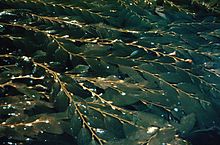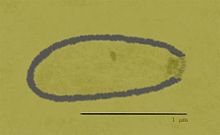
Largest organisms

The largest organisms now found on Earth can be determined according to various aspects of an organism's size, such as: mass, volume, area, length, height, or even genome size. Some organisms group together to form a superorganism (such as ants or bees), but such are not classed as single large organisms. The Great Barrier Reef is the world's largest structure composed of living entities, stretching 2,000 km (1,200 mi), but contains many organisms of many types of species.
This article lists the largest species for various types of organisms and mostly considers extant species. The organism sizes listed are frequently considered "outsized" and are not in the normal size range for the respective group.
If considered singular entities, the largest organisms are clonal colonies which can spread over large areas. Pando, a clonal colony of the quaking aspen tree, is widely considered to be the largest such organism by mass. Even if such colonies are excluded, trees retain their dominance of this listing, with the giant sequoia being the most massive tree. In 2006 a huge clonal colony of the seagrass Posidonia oceanica was discovered south of the island of Ibiza. At 8 kilometres (5 mi) across, and estimated at around 100,000 years old, it may be one of the largest and oldest clonal colonies on Earth.
Among animals, the largest species are all marine mammals, specifically whales. The blue whale is believed to be the largest animal to have ever lived. The living land animal classification is also dominated by mammals, with the African bush elephant being the largest of these.
Plants
The largest single-stem tree by wood volume and mass is the giant sequoia (Sequoiadendron giganteum), native to Sierra Nevada and California; it typically grows to a height of 70–85 m (230–280 ft) and 5–7 m (16–23 ft) in diameter.
The largest organism in the world, according to mass, is the aspen tree whose colonies of clones can grow up to 8 kilometres (5 mi) long. The largest such colony is Pando, in the Fishlake National Forest in Utah.
A form of flowering plant that far exceeds Pando as the largest organism on Earth in area and probably also mass, is the giant marine plant, Posidonia australis, living in Shark Bay, Australia. Its length is about 180 km (112 mi) and it covers an area of 200 km2 (77 sq mi). It is among the oldest known clonal plants too.
Another giant marine plant of the genus Posidonia, Posidonia oceanica discovered in the Mediterranean near the Balearic Islands, Spain may be the oldest living organism in the world, with an estimated age of 100,000 years.
The largest individual flower in the world is Rafflesia arnoldii, while the flowering plant with the largest unbranched inflorescence in the world is Amorphophallus titanum. Both are native to Sumatra island of Indonesia.
Green algae
Green algae are photosynthetic unicellular and multicellular protists that are related to land plants. The thallus of the unicellular mermaid's wineglass, Acetabularia, can grow to several inches (perhaps 0.1 to 0.2 m) in length. The fronds of the similarly unicellular, and invasive Caulerpa taxifolia can grow up to a foot (0.3 m) long.
Animals
The largest animal known ever to have lived is confirmed to be the blue whale (Balaenoptera musculus). The maximum recorded weight was 190 tonnes for a specimen measuring 27.6 metres (91 ft), whereas longer ones, up to 33.6 metres (110 ft), have been recorded but not weighed. It is estimated however that this individual could have a mass of 250 tonnes. The title of the longest non-colonial animal is probably held by the lion's mane jellyfish (36.6m / 120 ft).
The African bush elephant (Loxodonta africana) is the largest living land animal. A native of various open habitats in sub-Saharan Africa, males weigh about 6.0 tonnes (13,200 lb) on average. The largest elephant ever recorded was shot in Angola in 1974. It was a male measuring 10.67 metres (35.0 ft) from trunk to tail and 4.17 metres (13.7 ft) lying on its side in a projected line from the highest point of the shoulder to the base of the forefoot, indicating a standing shoulder height of 3.96 metres (13.0 ft). This male had a computed weight of 10.4 tonnes.Fungi
The largest living fungus may be a honey fungus of the species Armillaria ostoyae. A mushroom of this type in the Malheur National Forest in the Blue Mountains of eastern Oregon, U.S. was found to be the largest fungal colony in the world, spanning 8.9 km2 (2,200 acres) of area. This organism is estimated to be 2,400 years old. The fungus was written about in the April 2003 issue of the Canadian Journal of Forest Research. While an accurate estimate has not been made, the total weight of the colony may be as much as 605 tons. If this colony is considered a single organism, then it is the largest known organism in the world by area, and rivals the aspen grove "Pando" as the known organism with the highest living biomass. It is not known, however, whether it is a single organism with all parts of the mycelium connected.
A spatial genetic analysis estimated that a specimen of Armillaria ostoyae growing over 91 acres (37 ha) in northern Michigan, United States weighs 440 tons (4 x 105 kg). Approximations of the land area of the Oregon "humongous fungus" are 3.5 square miles (9.1 km2) (2,240 acres (910 ha), possibly weighing as much as 7,500 tons as the world's most massive living organism.
In Armillaria ostoyae, each individual mushroom (the fruiting body, similar to a flower on a plant) has only a 5 cm (2.0 in) stipe, and a pileus up to 12.5 cm (4.9 in) across. There are many other fungi which produce a larger individual size mushroom. The largest known fruiting body of a fungus is a specimen of Phellinus ellipsoideus (formerly Fomitiporia ellipsoidea) found on Hainan Island. The fruiting body masses up to 500 kg (1,100 lb).
Until P. ellipsoideus replaced it, the largest individual fruit body came from Rigidoporus ulmarius. R. ulmarius can grow up to 284 kg (626 lb), 1.66 m (5.4 ft) tall, 1.46 m (4.8 ft) across, and has a circumference of up to 4.9 m (16 ft).
Lichen
Umbilicaria mammulata is among the largest lichens in the world. The thallus of U. mammulata is usually 4 to 15 cm (1.6 to 5.9 in) in diameter, but specimens have been known to reach 63-centimetre (2.07 ft) in the Smoky Mountains of Tennessee.
The longest lichen is Usnea longissima, which may grow to exceed 20 feet in length.
Protists

(Note: the group Protista is not used in current taxonomy.)
Amoebozoans (Amoebozoa)
- Among the organisms that are not multicellular, the largest are the slime molds, such as Physarum polycephalum, some of which can reach a diameter over 30 cm (12 in). These organisms are unicellular, but they are multinucleate.
Euglenozoans (Euglenozoa)
- Some euglenophytes, such as certain species of Euglena, reach lengths of 400 μm.
Rhizarians (Rhizaria)
- The largest species traditionally considered protozoa are giant amoeboids like foraminiferans. One such species, the xenophyophore Syringammina fragilissima, can attain a size of 20 cm (7.9 in).
Alveolates (Alveolata)
- The largest ciliates, such as Spirostomum, can attain a length over 4 mm (0.16 in).
Stramenopiles (Stramenopila)
- The largest stramenopiles are giant kelp from the northwestern Pacific. The floating stem of Macrocystis pyrifera can grow to a height of over 45 m (148 ft).
- Macrocystis also qualifies as the largest brown alga, the largest chromist, and the largest protist generally.
Bacteria
The largest known species of bacterium is named Thiomargarita magnifica, which grows to 1 cm (0.39 in) in length, making it visible to the naked eye and also about five thousand times the size of more typical bacteria.BBC News described it as possessing the "size and shape of a human eyelash."Science published a new paper on the bacterium on June 23, 2022. According to a study coauthored by Jean-Marie Volland, a marine biologist and scientist at California's Laboratory for Research in Complex Systems, and an affiliate at the US Department of Energy Joint Genome Institute, T. magnifica can grow up to 2 centimeters long.
- Cyanobacteria
- One of the largest "blue green algae" is Lyngbya, whose filamentous cells can be 50 μm wide.
Viruses
The largest virus on record is the Pithovirus sibericum with the length of 1.5 micrometres, comparable to the typical size of a bacterium and large enough to be seen in light microscopes. It was discovered in March 2014 in an ice core sample collected from a permafrost in Siberia. Prior to this discovery, the largest virus was the peculiar virus genus Pandoravirus, which have a size of approximately 1 micrometer and whose genome contains 1,900,000 to 2,500,000 base pairs of DNA.
Both these viruses infect amoebas specifically.
See also
- Charismatic megafauna
- Deep-sea gigantism
- Genome size
- Island gigantism
- Largest body part
- Largest prehistoric animals
- List of longest-living organisms
- List of heaviest land mammals
- List of world records held by plants
- List of largest inflorescences
- Lists of organisms by population
- List of longest vines
- Megafauna
- Smallest organisms
- Superorganism
| World records | |||||||||||||
|---|---|---|---|---|---|---|---|---|---|---|---|---|---|
| People | |||||||||||||
| Sporting records |
|
||||||||||||
| National records | |||||||||||||
| Motion records |
|
||||||||||||
| Structures | |||||||||||||
| Physical phenomena | |||||||||||||
External links
- 10 of the largest living things on the planet Melissa Breyer. TreeHugger April 28, 2015

